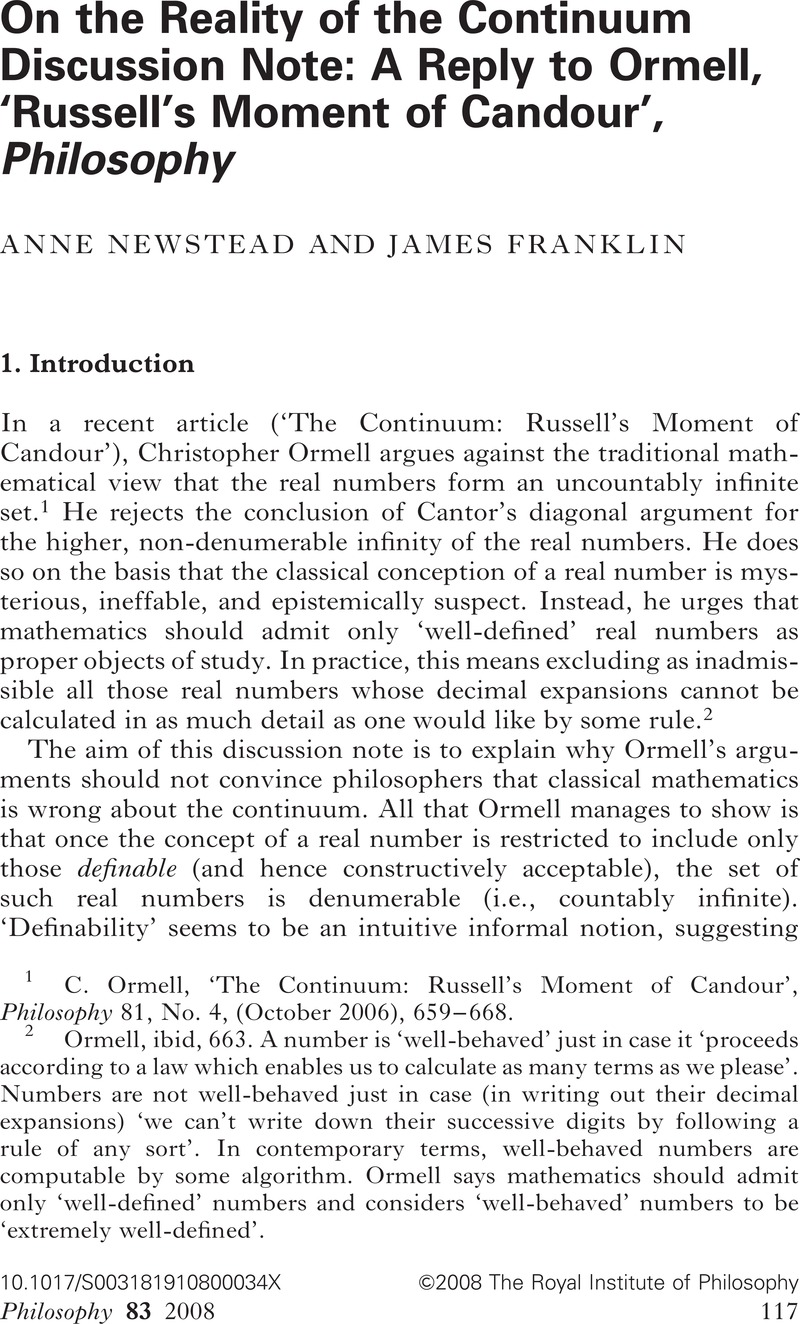Published online by Cambridge University Press: 21 February 2008

1 Ormell, C., ‘The Continuum: Russell's Moment of Candour’, Philosophy 81, No. 4, (October 2006), 659–668CrossRefGoogle Scholar.
2 Ormell, ibid, 663. A number is ‘well-behaved’ just in case it ‘proceeds according to a law which enables us to calculate as many terms as we please’. Numbers are not well-behaved just in case (in writing out their decimal expansions) ‘we can't write down their successive digits by following a rule of any sort’. In contemporary terms, well-behaved numbers are computable by some algorithm. Ormell says mathematics should admit only ‘well-defined’ numbers and considers ‘well-behaved’ numbers to be ‘extremely well-defined’.
3 Indeed, since definable numbers must be defined using countably many symbols, the countability of definable numbers follows immediately.
4 One could further infer from (3) using classical logic that
(4) There exist indefinable real numbers.
Some constructivists would also reject the inference to step (4) from (3), because the transition
is not valid in intuitionist logic. However, even constructivists who maintain classical logic will want to reject the argument on the basis of step (3).
5 One person's modus ponens is another's modus tollens tollens. That is, classical mathematicians argue that because reals are uncountable (as established by the diagonal argument), there must be indefinables. The constructivists argue that because there could not be indefinable numbers (given their philosophical conception of numbers), therefore the reals are countable.
6 On the charge of idealism leading philosophers astray when contemplating the continuum, see Franklin, J., ‘Achievements and fallacies in Hume's account of infinite divisibility’, Hume Studies 20 (1994), 85–101Google Scholar.
7 The objection is common to Peirce, Brouwer, and Wittgenstein in their reactions to Cantor's argument.
8 Hallett, M., Cantorian Set Theory and Limitation of Size (Oxford: Oxford Logic Guides, 1994), 7Google Scholar.
9 Dummett, M., Elements of Intuitionism (Oxford: Clarendon Press, 1977), 57Google Scholar. (Ormell makes it clear that he is not an intuitionist, but as with Wittgenstein, he does share some of the early Brouwer's views.)
10 This result is sometimes proved using the Axiom of Choice which is not constructively acceptable, but it can be proved using countable choice.
11 Ormell, ibid, p. 667.
12 To lay our cards on the table, we are sympathetic to empiricism, but only of a realist (Aristotelian) variety. We hold that some very basic mathematical properties such as symmetry and ratios may be perceptible. We think that there could be real physical continua with the structure of the continuum, although it is an open question. We are sympathetic to the ‘Aristotelian account’ outlined in D. Gillies, ‘An Empiricist Philosophy of Mathematics and its Implications for the History of Mathematics’, The Growth of Mathematical Knowledge, E. Grosz and H.Breger, (eds.), 46–51.
13 Ormell, ibid, p. 664.
14 Potter, M., Set Theory and its Philosophy (Oxford: Oxford University Press, 2004), 137CrossRefGoogle Scholar. On the acceptability of impredicative definitions for classes, see Giaquinto, M., The Search for Certainty, (Oxford: Oxford University Press, 2002), 107Google Scholar.
15 This kind of reasoning is very close to Wittgenstein, L., Philosophical Grammar, (Oxford: Blackwell, 1974), p. 477Google Scholar. Here Wittgenstein states that all we have done is marked out an interval rather than closed in on a particular real number.
16 Cantor's diagonal technique is one such rule for constructing a well-defined real number.
17 Ormell, ibid, p. 664.
18 Cf. N.Wildberger, ‘Set Theory: Should You Believe?’, http://web.maths.unsw.edu.au/~norman/papers/SetTheory.pdf, April 2006.
19 We prescind from the current debate over whether there are really eight or nine planets.
20 Wittgenstein, L., Remarks on the Foundations of Mathematics, ed. von Wright, G.H., Rhees, R., and Anscombe, GEM, (Oxford: Blackwell, 1978), §19, .131Google Scholar.
21 Ormell, ibid, p. 664 fn. 9.
22 Schechter, Eric, ‘Constructivism is Difficult’, The American Mathematical Monthly, 108, No. 1, January 2001, 50–54CrossRefGoogle Scholar.
23 Chaitin, Gregory, ‘The limits of reason’, Scientific American 294, No. 3 (March, 2006), 74–81CrossRefGoogle ScholarPubMed.
24 On the interpretation of Wittgenstein as a proponent of ‘the algorithmic standpoint’, see Marion, M., Wittgenstein, Finitism, and the Foundations of Mathematics (Oxford: Clarendon Press, 1998)Google Scholar.
25 Hilbert, D., ‘Über das Unendliche’, translated by Putnam, E. and Massey, G.J. as ‘On the Infinite’ in Putnam, H. and Benacerraf, P., eds., Philosophy of Mathematics (Cambridge: Cambridge University Press, 1983), 191Google Scholar.
26 L. Wittgenstein, op.cit., V. 7, p. 264.